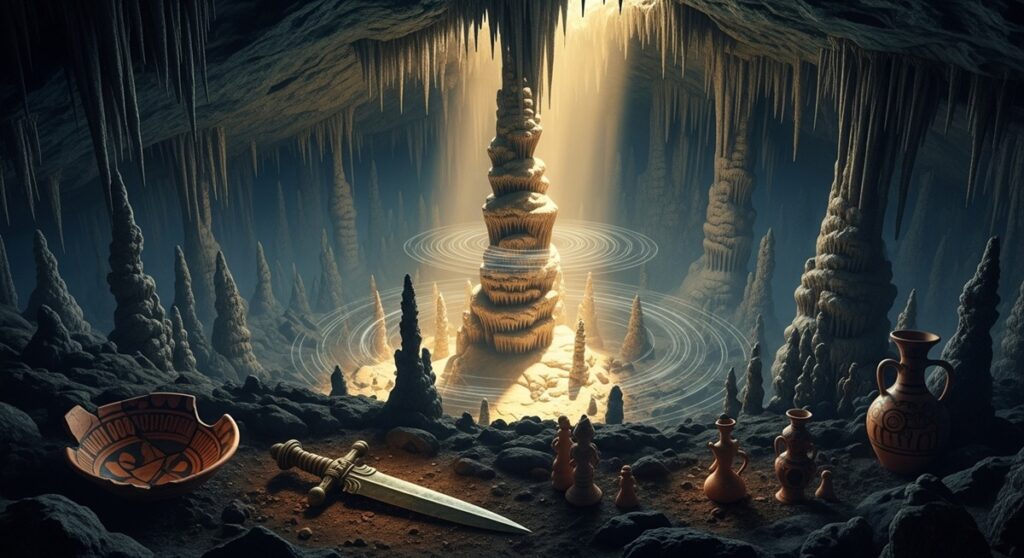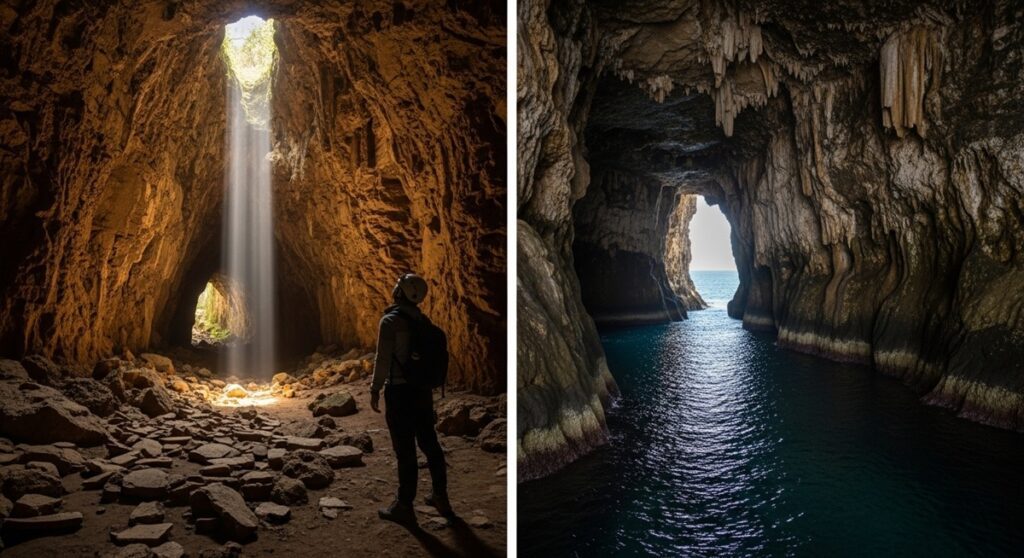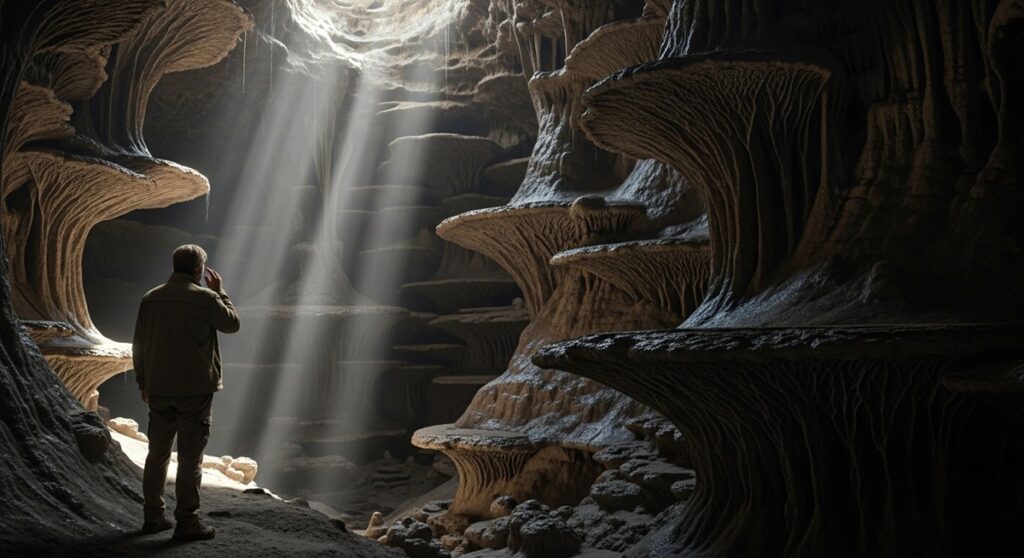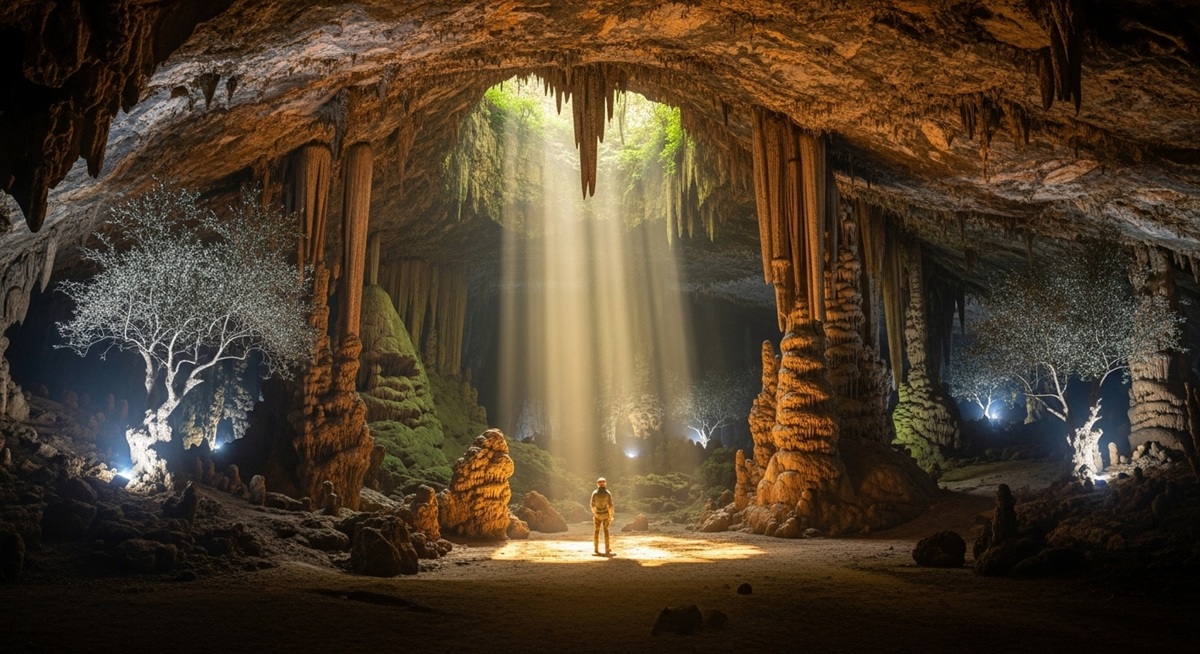Crete is an island that has always spoken in whispers and echoes. From the rolling seas that once carried Minoan ships to the mountain peaks where Zeus was said to be born, every part of Crete feels touched by myth. Yet, among its most enchanting natural wonders are the strange acoustic caves—subterranean chambers where stone sings, echoes linger, and the past seems to reverberate into the present.
These mystical caves are not only natural phenomena but also places where Greek mythology and sacred ritual intertwine. Visiting them today offers travelers a rare chance to experience a kind of sonic magic that feels at once ancient and eternal. Imagine stepping into a world where your voice bounces off walls carved by time, blending with legends of gods and nymphs. It’s this unique fusion that makes Crete a top destination for those seeking more than just beaches and ruins—it’s a journey into the audible heart of antiquity.
The Mystical Acoustics of Crete’s Caves
The strange acoustic caves of Crete are geological marvels formed over millennia by water erosion, volcanic activity, and tectonic shifts. Their unique interiors—often featuring vaulted ceilings, irregular walls, and mineral deposits—amplify and distort sound in extraordinary ways. A simple whisper can transform into a haunting melody, while a clap of the hands reverberates like distant thunder, creating an immersive soundscape that defies explanation.
Local folklore has long attributed these echoes to the voices of gods, nymphs, or even the Earth itself speaking back to mortals. To stand inside one is to experience a soundscape unlike any concert hall or cathedral—the rocks themselves seem alive, resonating with an almost divine timbre. Scientists explain this through principles of acoustics: the caves act as natural amplifiers, with sound waves reflecting off smooth surfaces and creating prolonged reverberations. But for ancient Cretans, these weren’t just physical effects; they were portals to the divine.
What draws modern visitors? It’s the thrill of interacting with these spaces. Many report a sense of awe, as if the caves are whispering secrets from the past. In an era dominated by digital noise, these natural echo chambers offer a raw, unfiltered connection to the world, making them essential stops on any Greek travel itinerary focused on Crete tourism.
How Acoustics Shape Myth and Experience
The interplay between sound and space in Crete‘s caves isn’t new—it’s embedded in Greek mythology. Echo, the nymph cursed by Hera to only repeat others’ words, embodies this phenomenon. Her story mirrors the caves’ ability to throw back sounds, turning human utterances into eternal loops. Travelers often feel this mythic echo when testing the acoustics, their words lingering like ghostly responses.
From a tourism perspective, these acoustic caves provide interactive experiences that set Crete apart from other Greek islands. Unlike static ruins, they engage multiple senses, inviting visitors to sing, chant, or even recite ancient hymns. This participatory element boosts engagement, turning passive sightseeing into active exploration.
Zeus and the Caves of Birth
Among the most famous caves of Crete is the Ideon Cave on Mount Ida, believed to be the birthplace of Zeus. Ancient hymns describe how nymphs raised the infant god here, hiding his cries from his father Kronos by clashing cymbals and shields. Some legends suggest the strange acoustics of the cave masked the sound of the newborn’s wails, protecting him from discovery and allowing him to grow into the king of the gods.
When you step into Ideon Cave today, the echoes feel like remnants of those divine cries, still resonating in the dark. The cave itself has become a pilgrimage site not just for myth-lovers but also for travelers seeking to feel closer to the sacred mystery of creation. Located at an elevation of about 1,500 meters, the hike to the entrance offers panoramic views of olive groves and rugged peaks, blending physical challenge with spiritual reward.

Archaeological finds, including votive offerings from Minoan times, underscore its historical significance. As part of Crete‘s broader tourism landscape, Ideon Cave pairs perfectly with nearby sites like the ancient city of Anogeia, known for its traditional Cretan music and festivals that echo the cave‘s sonic heritage.
Hiking to Ideon Cave: A Traveler’s Guide
Planning a visit? Start from the village of Anogeia, a hub of Crete tourism with charming tavernas serving local specialties like lamb and raki. The trail to Ideon Cave is moderately strenuous, taking about 1-2 hours uphill. Wear sturdy hiking boots—the path can be rocky and slippery after rain.
Once inside, the cool air and dim light enhance the acoustics. Try whispering a prayer to Zeus; the echo might just feel like a godly reply. For the best experience, join a guided tour that includes mythological storytelling, available through local operators in Rethymno or Heraklion.
Echoes of Nymphs and Sacred Rituals
Another sacred site is the Dikteon Cave in eastern Crete, also tied to the story of Zeus. Here, the acoustics are said to carry the soft songs of nymphs who once worshipped within its chambers. The Minoans, Crete’s first great civilization dating back to 3000 BCE, transformed caves like Dikteon into shrines, decorating them with offerings of pottery, bronze weapons, and ritual figurines unearthed by archaeologists.
The echoes in these caves were considered divine responses. To the ancient Cretans, every sound in the cave was the voice of the gods answering human prayers. Rituals often involved chanting or music, amplified by the natural reverb, creating trance-like states that blurred the line between mortal and immortal.

Today, Dikteon Cave dazzles with its stunning stalactites and stalagmites, forming a natural cathedral. Situated on the Lasithi Plateau, it’s easily accessible and combines well with visits to nearby windmills and traditional villages, making it a highlight of Greek travel routes.
Minoan Mysteries and Modern Echoes
The Minoans viewed caves as wombs of the Earth goddess, linking them to fertility rites. Artifacts from Dikteon include double axes symbolizing divine power, now housed in the Heraklion Archaeological Museum—a must-visit for context.
For contemporary travelers, the cave‘s acoustics inspire creative pursuits. Musicians and sound artists flock here, recording ambient tracks that capture the mythic essence. If you’re into wellness tourism, consider a sound bath session offered by some eco-tour operators, where guided meditations use the echoes for deep relaxation.
The Singing Stones: A Modern Experience
Today, explorers and travelers to Crete often describe the experience of entering these caves as spiritual and surreal. Tour guides sometimes demonstrate the acoustics by singing or chanting, their voices multiplying in waves across the rocky chambers, evoking ancient ceremonies.
In some smaller caves near Rethymno and Heraklion, the echoes are so clear that locals call them “singing stones.” These caves, less visited than Ideon or Dikteon, remain hidden gems for travelers seeking an off-the-beaten-path adventure infused with myth and mystery. Places like the Melidoni Cave, with its tragic history tied to Ottoman sieges, add layers of poignancy—its acoustics now echo tales of resilience as well as divinity.
Venturing further, the Sfentoni Cave in Zoniana boasts one of the island’s most impressive acoustic profiles, with chambers that produce harmonic overtones. It’s part of Crete‘s growing eco-tourism scene, where sustainable practices ensure these wonders endure.
Off-the-Path Caves and Hidden Treasures
For the intrepid, explore the Kamares Cave on Mount Psiloritis, linked to Minoan pottery production. Its echoes, combined with prehistoric artifacts, offer a raw glimpse into ancient life. Or head to the Milatos Cave, where legends of sea nymphs persist, and the acoustics mingle with the sound of nearby waves.

These lesser-known spots highlight Crete‘s diversity, from coastal retreats to mountainous escapes, all under the umbrella of Greek mythology and tourism.
Travel Tips: How to Explore Crete’s Acoustic Caves
Planning your Crete travel adventure? Here’s how to make the most of these sonic sanctuaries.
Start with Ideon Cave (Mount Ida): Accessible from the village of Anogeia, it’s the most famous mythical cave and offers breathtaking mountain scenery along the way. Combine it with a stay in a traditional guesthouse for authentic Cretan hospitality.
Visit Dikteon Cave (Lasithi Plateau): Known for both its stunning stalactites and its sacred history as a Minoan shrine. Entry fees are modest, and the site includes a short hike with rewarding views.
Look for Lesser-Known Caves: Ask locals about small acoustic caves in central Crete—these often lack tourist infrastructure but reward you with solitude and mystery. Caves like Agios Ioannis near Heraklion provide intimate experiences.
Best Time to Visit: Early morning or late afternoon, when the crowds thin and the caves feel like temples of sound. Avoid peak summer heat; spring and fall offer milder weather ideal for hiking.
What to Bring: A flashlight, sturdy shoes, and perhaps a short poem or song to test the echoes yourself. Don’t forget water and snacks—some sites are remote.
Transportation: Rent a car for flexibility, as public buses are limited in rural areas. From major hubs like Chania or Heraklion airports, drives to these sites range from 1-3 hours.
Accommodations: Opt for eco-lodges on the Lasithi Plateau or boutique hotels in Rethymno, many of which offer mythology-themed tours.
Safety Note: Always check weather conditions, as flash floods can affect caves. Guided tours are recommended for first-timers.
Pairing Caves with Broader Crete Tourism
Extend your trip by linking acoustic caves to other attractions. After Dikteon, visit the Palace of Knossos, the heart of Minoan civilization, where myths of the Minotaur come alive. Or relax on Elafonisi Beach, blending sonic adventures with seaside bliss.
For foodies, sample Cretan cuisine—think dakos salad and mountain herbs— at tavernas near the caves, where locals share folklore over meals.
An Ancient Understanding
The strange acoustic caves of Crete are bridges between the physical and spiritual, nature and mythology, science and faith. They remind us that sound itself has always been part of humanity’s dialogue with the divine, from Orphic hymns to modern mindfulness practices.

In the age of headphones and digital soundscapes, to hear the raw, resonant voice of the Earth in these caves is both grounding and otherworldly. It connects travelers to an ancient understanding: that to listen is to worship, and that sometimes the gods do answer—if only in echoes.
From a tourism standpoint, these sites boost Crete‘s appeal as a niche destination, attracting eco-conscious visitors and cultural enthusiasts. Preservation efforts, supported by UNESCO recognition of Minoan sites, ensure future generations can experience this heritage.
Scientific Insights into Mythic Sounds
Geologists note that Crete‘s karst landscape, rich in limestone, creates ideal conditions for acoustics. Studies on reverberation times in places like Ideon Cave reveal echoes lasting up to 10 seconds, far longer than man-made spaces. This scientific lens enhances the mythic allure, proving how natural wonders inspired Greek mythology.
Crete’s Eternal Echoes
Exploring these strange acoustic caves is a mythic pilgrimage. Here, in the cool darkness of stone chambers, the island tells its stories through sound.
Whether you come as a myth-seeker, a geologist, or simply a curious traveler, you leave with a memory etched in echo—proof that in Crete, the gods still speak, if you know how to listen. As you plan your Greek travel to this enchanting island, let the echoes guide you to a deeper appreciation of its timeless magic.





















